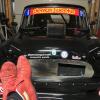Moke spider, I find your suggestion for the pressure sensing quite disingenuous.
Both you and Nick have failed to grasp that the specific braking situation for which this system is being proposed is NOT THE most effective stop. Go and RTFQ.
Nick, go out to your Mini or Mini based variant, sit in the driver’s seat and push the brake pedal as hard as you can. Then do the same at night, when it’s raining, when it’s dry, park it on some cobble stones, in a forest, do the same again when it’s icy, jack it up in the air, take the wheels off try any circumstance you care for. Now if you could measure the pressure in the braking system each time you performed this test do you think it would have a uniform value?
Then take yourself for a drive, anywhere you like, any surface, any weather, try a field. But get over 30mph to make it more exiting for yourself and then repeat what you did when parked, push with the same force and don’t let go. Now ignore any noise the tyres might make, the direction you’re going in and the angle you’re travelling. Would the pressure in the braking system be similar to the value when you were parked? Is this type of braking normal?
If you put a pressure P on the pedal, the pressur ein the system will always be P*X, with X being the leverage factor of the brake pedal .
Force on the brakes themselves depends on the master cylinder bore ,brake line bores,...
Its simple physics. F= p x A. But it WILL remain constant unless you pop a hose.
If you do not understand this simple physics, please don't consider 'inventing' a brake system.
Edited by Dusky, 26 October 2015 - 01:52 PM.




















